Unit 3 Animals单元整体设计表格式教案
文档属性
| 名称 | Unit 3 Animals单元整体设计表格式教案 |
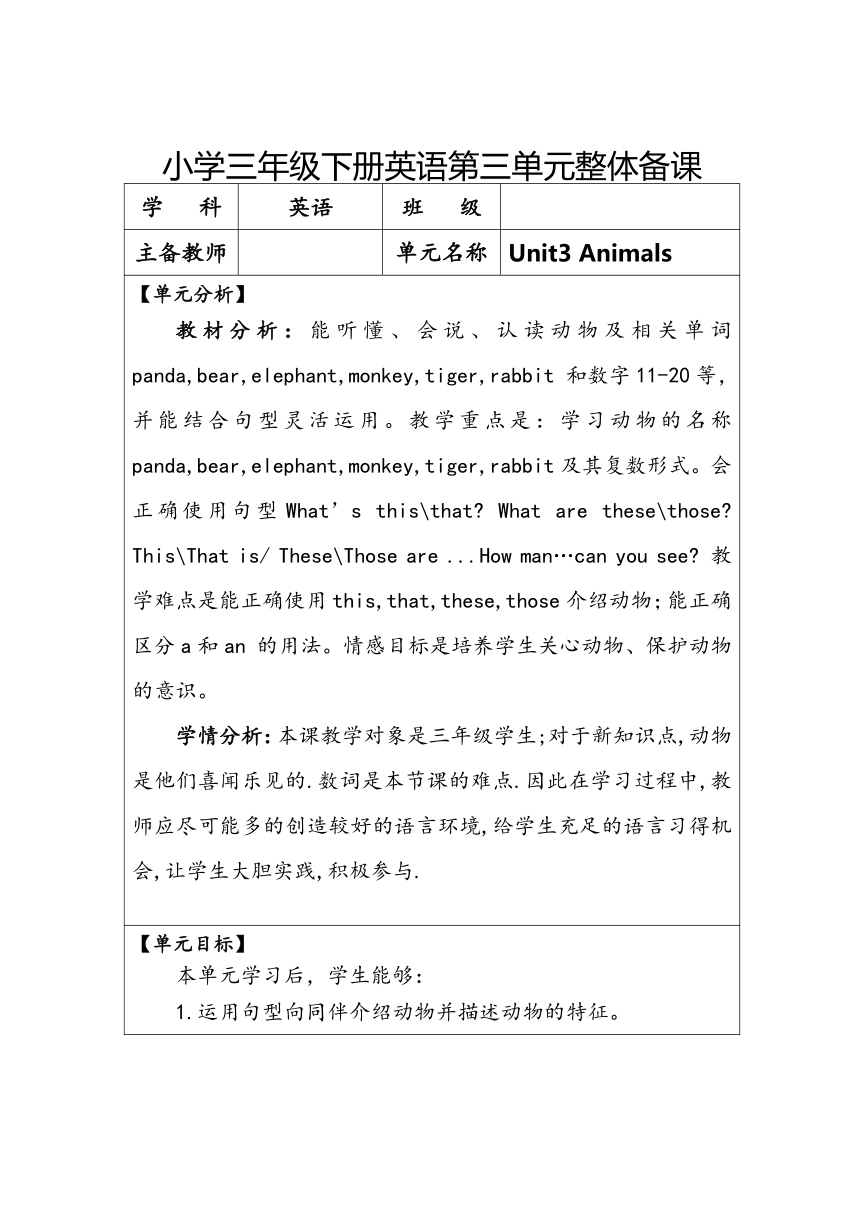
|
|
| 格式 | docx | ||
| 文件大小 | 73.9KB | ||
| 资源类型 | 教案 | ||
| 版本资源 | 鲁科版(五四制) | ||
| 科目 | 英语 | ||
| 更新时间 | 2024-06-24 17:56:56 | ||
图片预览

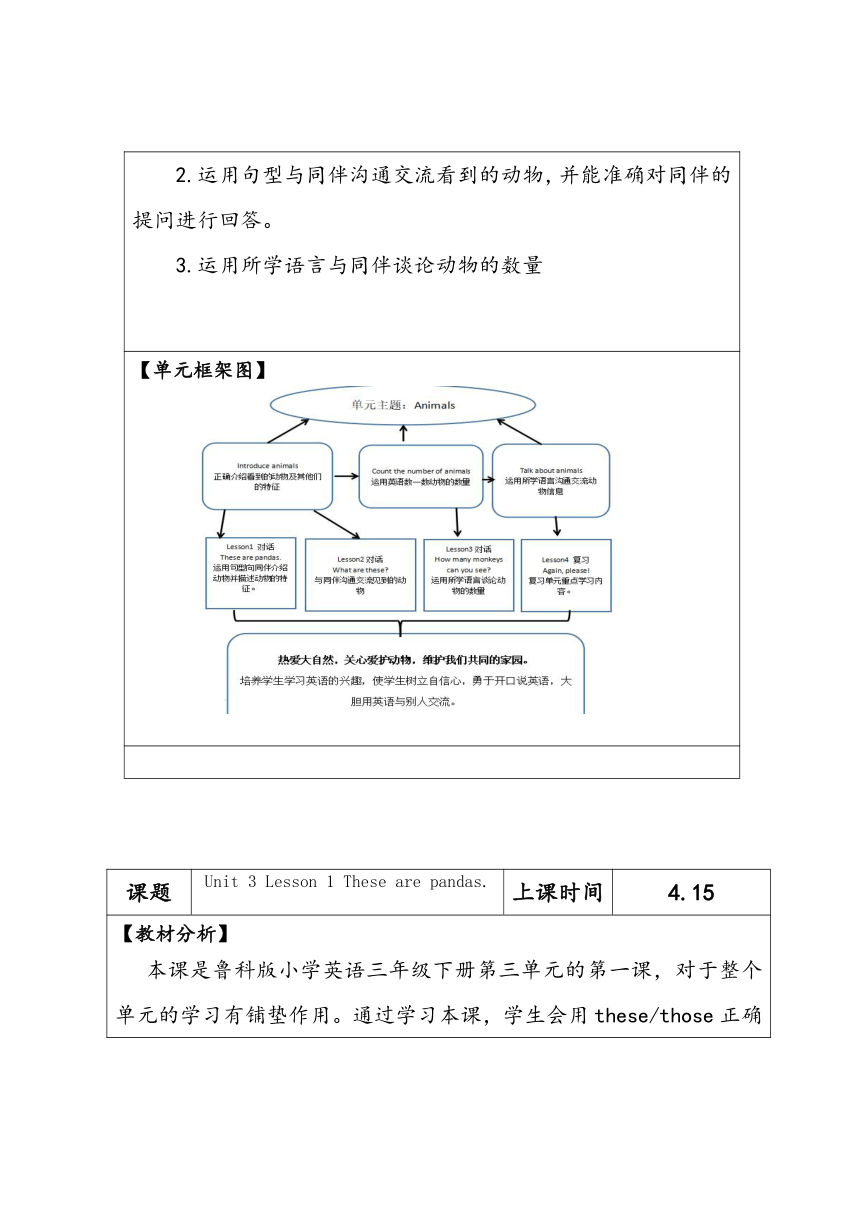
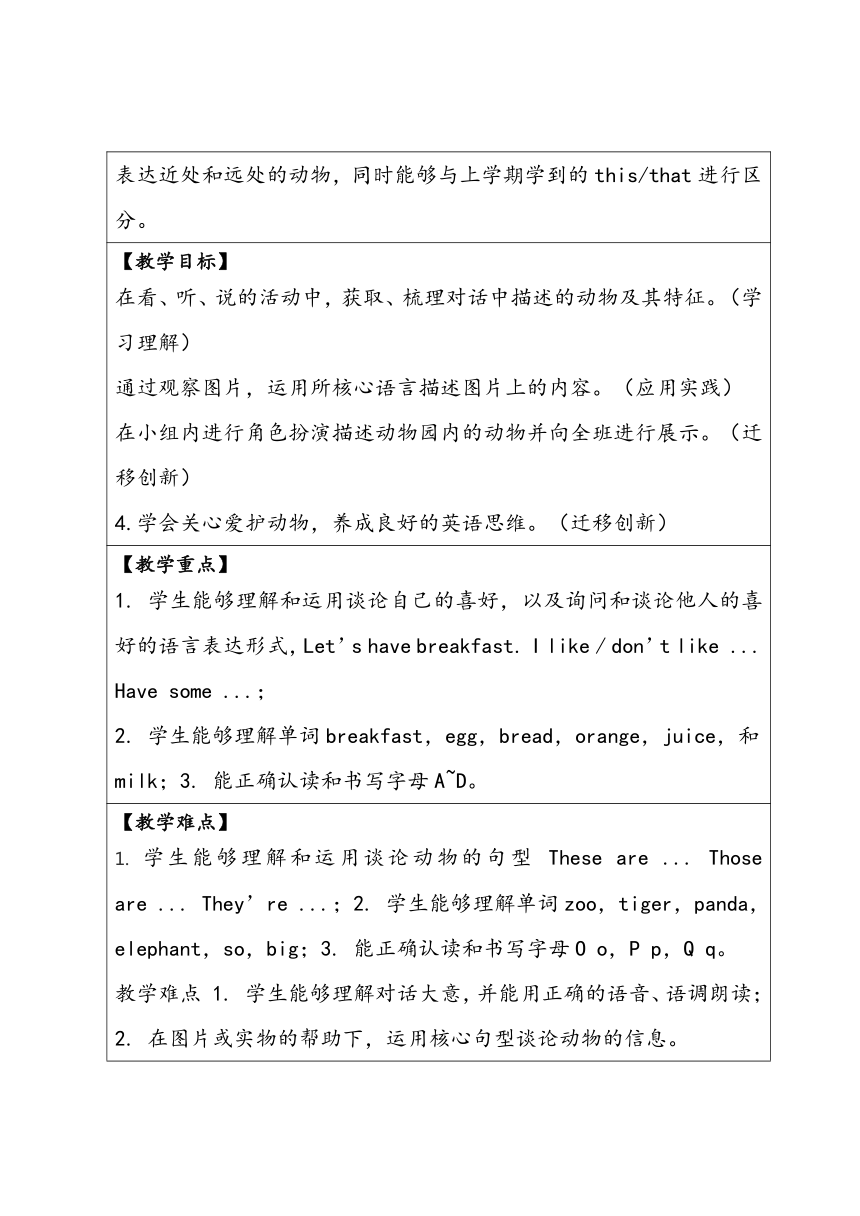
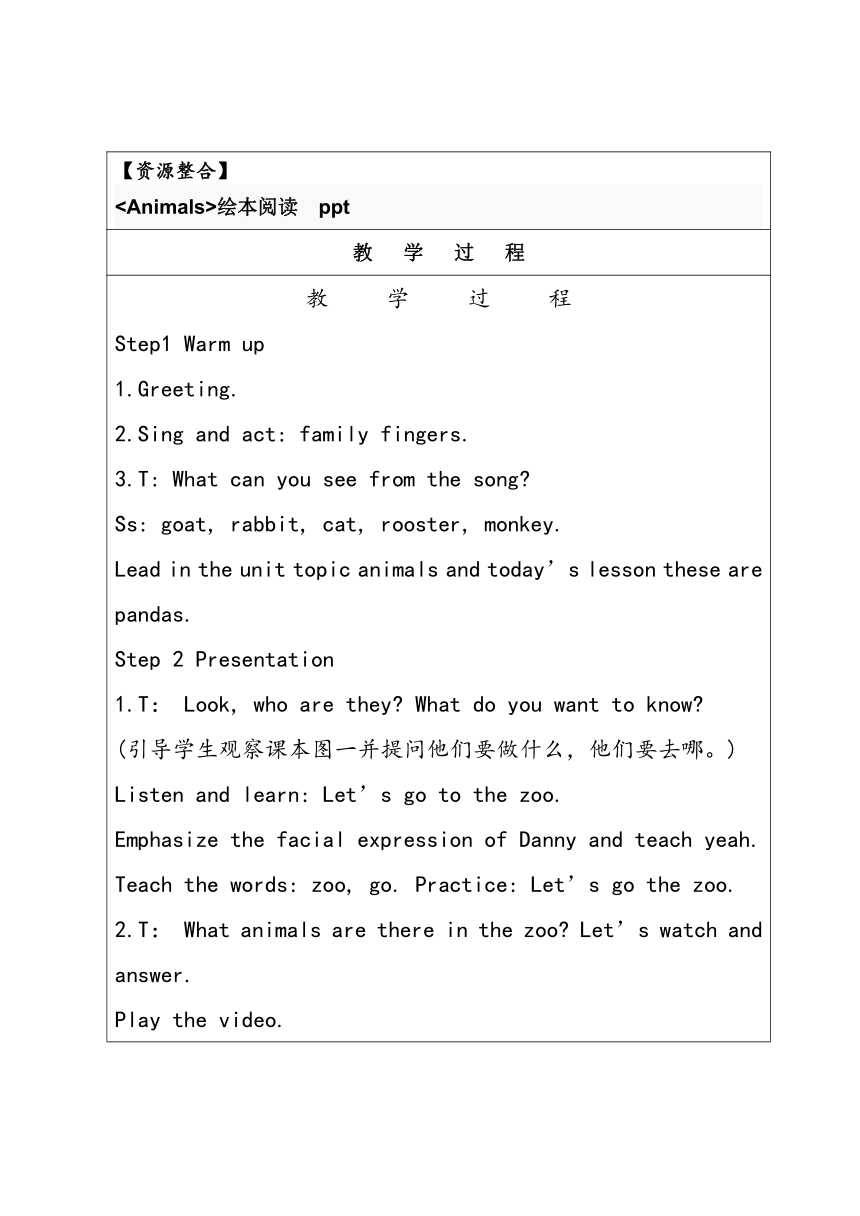
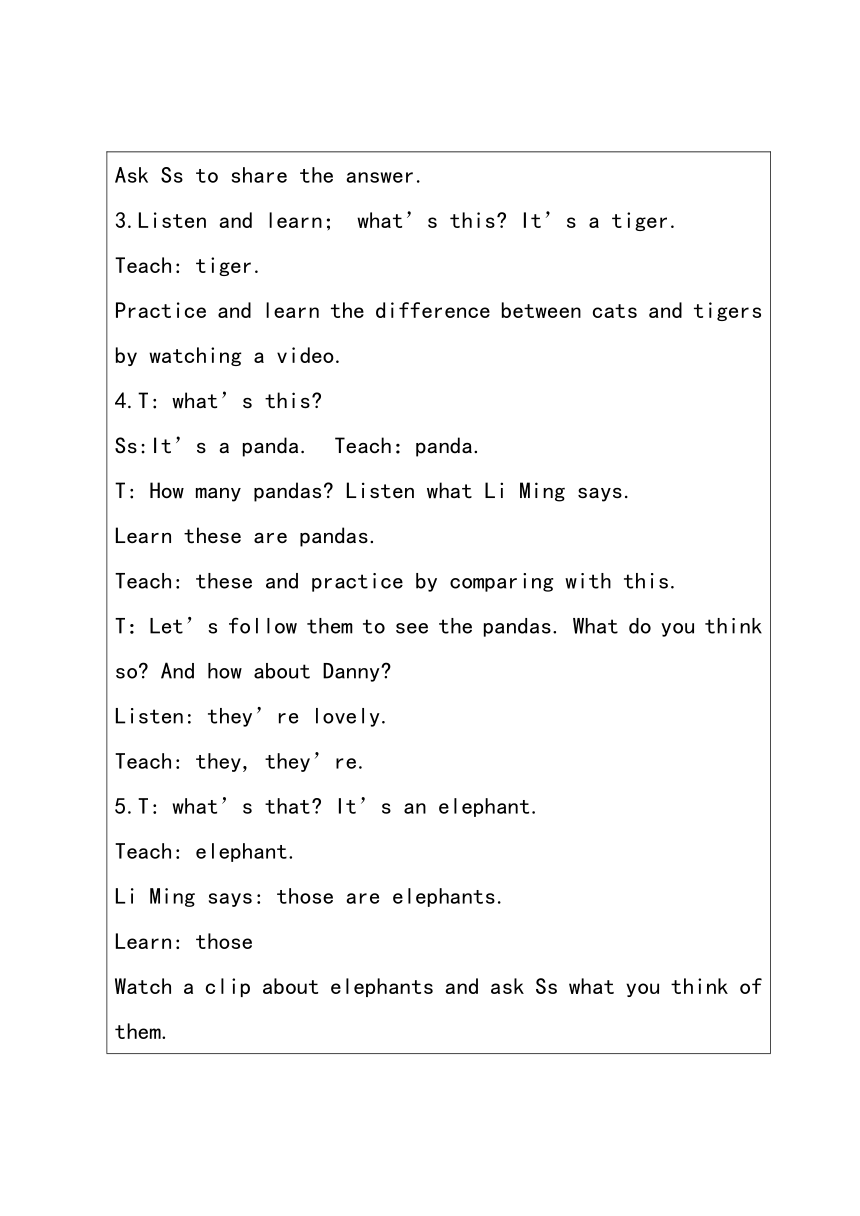
文档简介
小学三年级下册英语第三单元整体备课
学 科 英语 班 级
主备教师 单元名称 Unit3 Animals
【单元分析】 教材分析:能听懂、会说、认读动物及相关单词panda,bear,elephant,monkey,tiger,rabbit 和数字11-20等,并能结合句型灵活运用。教学重点是:学习动物的名称panda,bear,elephant,monkey,tiger,rabbit及其复数形式。会正确使用句型What’s this\that What are these\those This\That is/ These\Those are ...How man…can you see 教学难点是能正确使用this,that,these,those介绍动物;能正确区分a和an 的用法。情感目标是培养学生关心动物、保护动物的意识。 学情分析:本课教学对象是三年级学生;对于新知识点,动物是他们喜闻乐见的.数词是本节课的难点.因此在学习过程中,教师应尽可能多的创造较好的语言环境,给学生充足的语言习得机会,让学生大胆实践,积极参与.
【单元目标】 本单元学习后,学生能够: 1.运用句型向同伴介绍动物并描述动物的特征。 2.运用句型与同伴沟通交流看到的动物,并能准确对同伴的提问进行回答。 3.运用所学语言与同伴谈论动物的数量
【单元框架图】
课题 Unit 3 Lesson 1 These are pandas. 上课时间 4.15
【教材分析】 本课是鲁科版小学英语三年级下册第三单元的第一课,对于整个单元的学习有铺垫作用。通过学习本课,学生会用these/those正确表达近处和远处的动物,同时能够与上学期学到的this/that进行区分。
【教学目标】 在看、听、说的活动中,获取、梳理对话中描述的动物及其特征。(学习理解) 通过观察图片,运用所核心语言描述图片上的内容。(应用实践) 在小组内进行角色扮演描述动物园内的动物并向全班进行展示。(迁移创新) 4.学会关心爱护动物,养成良好的英语思维。(迁移创新)
【教学重点】 1. 学生能够理解和运用谈论自己的喜好,以及询问和谈论他人的喜好的语言表达形式,Let’s have breakfast. I like / don’t like ... Have some ...; 2. 学生能够理解单词breakfast,egg,bread,orange,juice,和milk;3. 能正确认读和书写字母A~D。
【教学难点】 1. 学生能够理解和运用谈论动物的句型 These are ... Those are ... They’re ...;2. 学生能够理解单词zoo,tiger,panda,elephant,so,big;3. 能正确认读和书写字母O o,P p,Q q。 教学难点 1. 学生能够理解对话大意,并能用正确的语音、语调朗读; 2. 在图片或实物的帮助下,运用核心句型谈论动物的信息。
【资源整合】绘本阅读 ppt
教 学 过 程
教 学 过 程 Step1 Warm up 1.Greeting. 2.Sing and act: family fingers. 3.T: What can you see from the song Ss: goat, rabbit, cat, rooster, monkey. Lead in the unit topic animals and today’s lesson these are pandas. Step 2 Presentation 1.T: Look, who are they What do you want to know (引导学生观察课本图一并提问他们要做什么,他们要去哪。) Listen and learn: Let’s go to the zoo. Emphasize the facial expression of Danny and teach yeah. Teach the words: zoo, go. Practice: Let’s go the zoo. 2.T: What animals are there in the zoo Let’s watch and answer. Play the video. Ask Ss to share the answer. 3.Listen and learn; what’s this It’s a tiger. Teach: tiger. Practice and learn the difference between cats and tigers by watching a video. 4.T: what’s this Ss:It’s a panda. Teach:panda. T: How many pandas Listen what Li Ming says. Learn these are pandas. Teach: these and practice by comparing with this. T:Let’s follow them to see the pandas. What do you think so And how about Danny Listen: they’re lovely. Teach: they, they’re. 5.T: what’s that It’s an elephant. Teach: elephant. Li Ming says: those are elephants. Learn: those Watch a clip about elephants and ask Ss what you think of them. Listen Danny says:so big. Teach so big. 应用实践: Step 3 Practice 1.Read long. 2.Dub 3.Work in pairs to introduce animals. 迁移创新 Step4 Production. 1.Work in group: to be a little guide of the zoo. Choose at lease 2 animals to your group members. 2.Watch a video about the animals and learn to love and protect them. 3.Letter time: teach letter Oo, Pp, Qq Step 5 Summary Do a test and make a summary. Step 6 Homework 1. Listen and repeat the text. 2. Search for more animals from the Internet. 3. Draw a map for your zoo, and introduce to your friends.
板书设计: U3 L1 These are pandas. They’re lovely. Those are elephants. So big.
课题 Lesson 2 What are these 上课时间 4.18
【教材分析】 本单元的话题是谈论动物及其数量。本节课是本单元的第二课时,教材通过Li Ming,Jenny和Danny在动物园问答动物名称的情景,让学生感知功能句型 What are these What are those They’re ... 的语用情境。本课时新学的三个动物单词bear,rabbit和monkey学生比较熟悉,教师可结合句型帮助学生记忆并实际运用。
【教学目标】 在看、听、说、读活动中,获取并梳理对话中远处及近处动物,如何提问及回答。(学习理解) 通过观察图片,运用句型转述李明一行看到的动物。(应用实践) 3.通过小组合作构思动物园及讨论参观所遇到的动物和他们的特征。(迁移创新)
【教学重点】 1. 学生能够理解和运用“问答动物名称”的语言表达形式What are these What are those They’re ...; 2. 学生能够理解单词bear,rabbit和monkey。
【教学难点】 1. 学生能够理解对话大意,并能用正确的语音、语调朗读; 2. 在图片或实物的帮助下,运用核心句型交流有关问答动物名称的信息。
【资源整合】 《Animals, Animals》绘本阅读 ppt
教 学 过 程
Step 1 Warm-up 1. Bomb game T: Hello, everyone. Nice to see you again! Now you will see six sentences. You should read them as soon as you can. However, you can’t read the sentence with a bomb. Watch and review T: Now please watch a video and review the sentence “What's this ” Step 2 Presentation Look, listen and learn a. What's this It’s a tiger. What are these They’re tigers. b. Show a picture of a rabbit near you and lead to rabbit c. Show a picture of a monkey in the distance and lead to monkey d. Let's go and see the monkeys 2. Listen and follow The teacher plays the animation or recording of listen and say and asks the students to listen and follow. T: OK! This time you should listen and follow. Step 3 Practice 1. Role-play in groups T: I’m going to divide the class into groups of three. Each group will play the conversations in roles. After then, two or three groups have to come to the front of the classroom to show your conversations. Listen and follow T: Look at the sentences on the PPT. You are going to ask and answer in pairs. Listen and sing Step 4Production Draw and say Mime, ask and answer T: Great! Now I want three of you to come here. Two students will mime an animal we’ve learned; one will ask and answer with the others. You can use the sentences on the PPT. 3. Summary Step 5 Homework
板书设计: Unit 3 Animals Lesson 2 What are these bear rabbit monkey (下面可粘贴相应的图片)What are these What are those They’re ...
课题 Lesson 3 How many monkeys can you see 上课时间 4.22
【教材分析】 本单元的话题是谈论动物及其数量。本节课是本单元的第三课时,教材继续通过Li Ming,Jenny和Danny在猴山前问答猴子的数量这一情景,让学生感知功能句型 How many ... can you see 的语用情境。由此学习eleven到twenty的数字单词。数字单词one到ten学生已经学习过,对于新的数字单词,教师可通过类比的方法进行教学,帮助学生有效率地记忆。
【教学目标】 通过本课时学习,学生能够: 1.在看、听、说、读的活动中,获取并梳理文本中看到的猴子的数量并理解第二十只猴子是谁。(学习理解) 2.在教师指导下,运用所学知识讨论动物的数量并进行角色扮演。(应用实践) 3.与同伴交流讨论问自己的文具数量。(迁移创新)
【教学重点】 1.学生能够理解和运用“问答动物的数量”的语言表达形式How many ... can you see ; 2. 学生能够理解单词eleven ~ twenty。
【教学难点】 1. 学生能够理解对话大意,并能用正确的语音、语调朗读; 2. 在图片或实物的帮助下,运用核心句型交流“问答动物的数量”的语言表达形式。
【资源整合】 Favorite Animals 绘本 ppt
教 学 过 程
Step 1 Warm-up 1. Sing and review T: Nice to see you again! First let’s listen and sing to review. Ask and answer Show the sentence patterns and the pictures and shapes of the words in the last lesson. Let the students review the questions and answers in pairs. T: Well done! Now please look at the pictures and tell me what the English phrases are. 3. Listen and review Play the song ten little Indian boys and review the number words. Activate the classroom atmosphere and review. Step 2 Presentation Look, listen and learn Show the picture of eleven o'clock on the clock and lead to eleven T: Now we’re going to learn some new words. Let’s look, listen and learn together. b. Show the pictures of the twelve zodiac signs and lead to twelve, c. Learn the seven words from thirteen to nineteen by analogy. d. Present the picture of the number 20, draw out twenty, and the dialogue twenty monkeys in the textbook P22 listen and say! Teaching words. e. How many monkeys can you see Learn can by listening. 2. Listen and follow T: OK! This time you should listen and follow. Step 3 Practice 1. Role-play in pairs T: Now three of you will play the conversations in groups. After then, two or three pairs have to come to the front of the classroom to show your conversations. 2. Listen and answer T: Well done! Now let’s learn how to write these three letters and learn how to pronounce each letter when it’s as the first letter of a word.4. Listen and copy. Step 4Production Choose and read T: Please look at the poker cards in my hands. Now you can choose one of the cards. And then I will tell you Chinese, and you can translate it into English. The times you read the English words are up to the numbers on the card. Turn and talk Students work in groups of three to carry out turntable Q & A activities. Step 5 Homework
板书设计: Unit 3 Animals Lesson 3 How many monkeys can you see R r S s T t(带有四线三格)eleven twelve thirteen fourteen fifteen sixteen seventeen eighteen nineteen twenty How many ... can you see
课题 Lesson4 Again,please 上课时间 4.26
本单元的话题是谈论动物及其数量。本节课是本单元的第四课时,作为复习总结课,本课时旨在通过问答练习和游戏活动,复习巩固本单元所学的重点词句。本单元涉及的单词除了动物单词,还有数字单词。单词较多,但都是学生比较熟悉的,教师可通过对单词的归类以及游戏、互动或练习活动,帮助学生在轻松的状态下回忆并掌握词句。
【教学目标】 1.在听说读看活动中,梳理并获取文本中Miss Zhang剪纸的动物及数量,同时复习本单元重点句型及词汇。(学习理解) 2.能够运用本单元句型与同伴一同讨论动物园里出现的动物及他们的数量。(应用实践) 3.向同伴介绍自己的文具以及他们的数量及特征。(迁移创新)
【教学重点】 1. 学生能够理解和运用“谈论动物及其数量”的语言表达形式These are ... Those are ... What are these What are those They’re ... How many ... can you see 2. 学生能够理解本单元所学的所有单词。
【教学难点】 1. 学生能够理解对话大意,并能用正确的语音、语调朗读; 2. 在图片或实物的帮助下,运用核心句型谈论动物及其数量。
【资源整合】 《Sleeping animals》绘本阅读 ppt
教 学 过 程
Step 1 Warm-up 1. Game——Bingo T: Welcome! First let’s have a game — petition T: Well done! Now let’s have a competition to see which group can write the most animal words. Step 2 Presentation Listen and circle Play the recording of let's talk in textbook p24. Let the students listen and choose the number of rabbits. Listen and follow Present the dialogue in let's talk in textbook p24, and play the recording. Let the students listen and follow. Step 3 Practice Role-play in groups Present the dialogue of let's talk in textbook p24. Ask students to work in groups of four and have a role dialogue. Watch and review Count and say Ask students to carefully observe the animal pictures on the blackboard in textbook p24 fun time, and then conduct a number of questions and answers between teachers and students. Step 4 Production Draw and say T: Now please take out your crayons. Five (or six) of you are in one group to draw some animals. Then you introduce and describe your animals. Yes or No T: Now you’ll see four sentences. You should tell me if they are right or wrong. If it is wrong, you can correct it. 3. Summarize and match. Step 5 Homework
板书设计: Unit 3 Animals Lesson 4 Again, please!zoo tiger panda elephant big bear rabbit monkey These are ... Those are ... What are these What are those They’re ... How many ... can you see
学 科 英语 班 级
主备教师 单元名称 Unit3 Animals
【单元分析】 教材分析:能听懂、会说、认读动物及相关单词panda,bear,elephant,monkey,tiger,rabbit 和数字11-20等,并能结合句型灵活运用。教学重点是:学习动物的名称panda,bear,elephant,monkey,tiger,rabbit及其复数形式。会正确使用句型What’s this\that What are these\those This\That is/ These\Those are ...How man…can you see 教学难点是能正确使用this,that,these,those介绍动物;能正确区分a和an 的用法。情感目标是培养学生关心动物、保护动物的意识。 学情分析:本课教学对象是三年级学生;对于新知识点,动物是他们喜闻乐见的.数词是本节课的难点.因此在学习过程中,教师应尽可能多的创造较好的语言环境,给学生充足的语言习得机会,让学生大胆实践,积极参与.
【单元目标】 本单元学习后,学生能够: 1.运用句型向同伴介绍动物并描述动物的特征。 2.运用句型与同伴沟通交流看到的动物,并能准确对同伴的提问进行回答。 3.运用所学语言与同伴谈论动物的数量
【单元框架图】
课题 Unit 3 Lesson 1 These are pandas. 上课时间 4.15
【教材分析】 本课是鲁科版小学英语三年级下册第三单元的第一课,对于整个单元的学习有铺垫作用。通过学习本课,学生会用these/those正确表达近处和远处的动物,同时能够与上学期学到的this/that进行区分。
【教学目标】 在看、听、说的活动中,获取、梳理对话中描述的动物及其特征。(学习理解) 通过观察图片,运用所核心语言描述图片上的内容。(应用实践) 在小组内进行角色扮演描述动物园内的动物并向全班进行展示。(迁移创新) 4.学会关心爱护动物,养成良好的英语思维。(迁移创新)
【教学重点】 1. 学生能够理解和运用谈论自己的喜好,以及询问和谈论他人的喜好的语言表达形式,Let’s have breakfast. I like / don’t like ... Have some ...; 2. 学生能够理解单词breakfast,egg,bread,orange,juice,和milk;3. 能正确认读和书写字母A~D。
【教学难点】 1. 学生能够理解和运用谈论动物的句型 These are ... Those are ... They’re ...;2. 学生能够理解单词zoo,tiger,panda,elephant,so,big;3. 能正确认读和书写字母O o,P p,Q q。 教学难点 1. 学生能够理解对话大意,并能用正确的语音、语调朗读; 2. 在图片或实物的帮助下,运用核心句型谈论动物的信息。
【资源整合】
教 学 过 程
教 学 过 程 Step1 Warm up 1.Greeting. 2.Sing and act: family fingers. 3.T: What can you see from the song Ss: goat, rabbit, cat, rooster, monkey. Lead in the unit topic animals and today’s lesson these are pandas. Step 2 Presentation 1.T: Look, who are they What do you want to know (引导学生观察课本图一并提问他们要做什么,他们要去哪。) Listen and learn: Let’s go to the zoo. Emphasize the facial expression of Danny and teach yeah. Teach the words: zoo, go. Practice: Let’s go the zoo. 2.T: What animals are there in the zoo Let’s watch and answer. Play the video. Ask Ss to share the answer. 3.Listen and learn; what’s this It’s a tiger. Teach: tiger. Practice and learn the difference between cats and tigers by watching a video. 4.T: what’s this Ss:It’s a panda. Teach:panda. T: How many pandas Listen what Li Ming says. Learn these are pandas. Teach: these and practice by comparing with this. T:Let’s follow them to see the pandas. What do you think so And how about Danny Listen: they’re lovely. Teach: they, they’re. 5.T: what’s that It’s an elephant. Teach: elephant. Li Ming says: those are elephants. Learn: those Watch a clip about elephants and ask Ss what you think of them. Listen Danny says:so big. Teach so big. 应用实践: Step 3 Practice 1.Read long. 2.Dub 3.Work in pairs to introduce animals. 迁移创新 Step4 Production. 1.Work in group: to be a little guide of the zoo. Choose at lease 2 animals to your group members. 2.Watch a video about the animals and learn to love and protect them. 3.Letter time: teach letter Oo, Pp, Qq Step 5 Summary Do a test and make a summary. Step 6 Homework 1. Listen and repeat the text. 2. Search for more animals from the Internet. 3. Draw a map for your zoo, and introduce to your friends.
板书设计: U3 L1 These are pandas. They’re lovely. Those are elephants. So big.
课题 Lesson 2 What are these 上课时间 4.18
【教材分析】 本单元的话题是谈论动物及其数量。本节课是本单元的第二课时,教材通过Li Ming,Jenny和Danny在动物园问答动物名称的情景,让学生感知功能句型 What are these What are those They’re ... 的语用情境。本课时新学的三个动物单词bear,rabbit和monkey学生比较熟悉,教师可结合句型帮助学生记忆并实际运用。
【教学目标】 在看、听、说、读活动中,获取并梳理对话中远处及近处动物,如何提问及回答。(学习理解) 通过观察图片,运用句型转述李明一行看到的动物。(应用实践) 3.通过小组合作构思动物园及讨论参观所遇到的动物和他们的特征。(迁移创新)
【教学重点】 1. 学生能够理解和运用“问答动物名称”的语言表达形式What are these What are those They’re ...; 2. 学生能够理解单词bear,rabbit和monkey。
【教学难点】 1. 学生能够理解对话大意,并能用正确的语音、语调朗读; 2. 在图片或实物的帮助下,运用核心句型交流有关问答动物名称的信息。
【资源整合】 《Animals, Animals》绘本阅读 ppt
教 学 过 程
Step 1 Warm-up 1. Bomb game T: Hello, everyone. Nice to see you again! Now you will see six sentences. You should read them as soon as you can. However, you can’t read the sentence with a bomb. Watch and review T: Now please watch a video and review the sentence “What's this ” Step 2 Presentation Look, listen and learn a. What's this It’s a tiger. What are these They’re tigers. b. Show a picture of a rabbit near you and lead to rabbit c. Show a picture of a monkey in the distance and lead to monkey d. Let's go and see the monkeys 2. Listen and follow The teacher plays the animation or recording of listen and say and asks the students to listen and follow. T: OK! This time you should listen and follow. Step 3 Practice 1. Role-play in groups T: I’m going to divide the class into groups of three. Each group will play the conversations in roles. After then, two or three groups have to come to the front of the classroom to show your conversations. Listen and follow T: Look at the sentences on the PPT. You are going to ask and answer in pairs. Listen and sing Step 4Production Draw and say Mime, ask and answer T: Great! Now I want three of you to come here. Two students will mime an animal we’ve learned; one will ask and answer with the others. You can use the sentences on the PPT. 3. Summary Step 5 Homework
板书设计: Unit 3 Animals Lesson 2 What are these bear rabbit monkey (下面可粘贴相应的图片)What are these What are those They’re ...
课题 Lesson 3 How many monkeys can you see 上课时间 4.22
【教材分析】 本单元的话题是谈论动物及其数量。本节课是本单元的第三课时,教材继续通过Li Ming,Jenny和Danny在猴山前问答猴子的数量这一情景,让学生感知功能句型 How many ... can you see 的语用情境。由此学习eleven到twenty的数字单词。数字单词one到ten学生已经学习过,对于新的数字单词,教师可通过类比的方法进行教学,帮助学生有效率地记忆。
【教学目标】 通过本课时学习,学生能够: 1.在看、听、说、读的活动中,获取并梳理文本中看到的猴子的数量并理解第二十只猴子是谁。(学习理解) 2.在教师指导下,运用所学知识讨论动物的数量并进行角色扮演。(应用实践) 3.与同伴交流讨论问自己的文具数量。(迁移创新)
【教学重点】 1.学生能够理解和运用“问答动物的数量”的语言表达形式How many ... can you see ; 2. 学生能够理解单词eleven ~ twenty。
【教学难点】 1. 学生能够理解对话大意,并能用正确的语音、语调朗读; 2. 在图片或实物的帮助下,运用核心句型交流“问答动物的数量”的语言表达形式。
【资源整合】 Favorite Animals 绘本 ppt
教 学 过 程
Step 1 Warm-up 1. Sing and review T: Nice to see you again! First let’s listen and sing to review. Ask and answer Show the sentence patterns and the pictures and shapes of the words in the last lesson. Let the students review the questions and answers in pairs. T: Well done! Now please look at the pictures and tell me what the English phrases are. 3. Listen and review Play the song ten little Indian boys and review the number words. Activate the classroom atmosphere and review. Step 2 Presentation Look, listen and learn Show the picture of eleven o'clock on the clock and lead to eleven T: Now we’re going to learn some new words. Let’s look, listen and learn together. b. Show the pictures of the twelve zodiac signs and lead to twelve, c. Learn the seven words from thirteen to nineteen by analogy. d. Present the picture of the number 20, draw out twenty, and the dialogue twenty monkeys in the textbook P22 listen and say! Teaching words. e. How many monkeys can you see Learn can by listening. 2. Listen and follow T: OK! This time you should listen and follow. Step 3 Practice 1. Role-play in pairs T: Now three of you will play the conversations in groups. After then, two or three pairs have to come to the front of the classroom to show your conversations. 2. Listen and answer T: Well done! Now let’s learn how to write these three letters and learn how to pronounce each letter when it’s as the first letter of a word.4. Listen and copy. Step 4Production Choose and read T: Please look at the poker cards in my hands. Now you can choose one of the cards. And then I will tell you Chinese, and you can translate it into English. The times you read the English words are up to the numbers on the card. Turn and talk Students work in groups of three to carry out turntable Q & A activities. Step 5 Homework
板书设计: Unit 3 Animals Lesson 3 How many monkeys can you see R r S s T t(带有四线三格)eleven twelve thirteen fourteen fifteen sixteen seventeen eighteen nineteen twenty How many ... can you see
课题 Lesson4 Again,please 上课时间 4.26
本单元的话题是谈论动物及其数量。本节课是本单元的第四课时,作为复习总结课,本课时旨在通过问答练习和游戏活动,复习巩固本单元所学的重点词句。本单元涉及的单词除了动物单词,还有数字单词。单词较多,但都是学生比较熟悉的,教师可通过对单词的归类以及游戏、互动或练习活动,帮助学生在轻松的状态下回忆并掌握词句。
【教学目标】 1.在听说读看活动中,梳理并获取文本中Miss Zhang剪纸的动物及数量,同时复习本单元重点句型及词汇。(学习理解) 2.能够运用本单元句型与同伴一同讨论动物园里出现的动物及他们的数量。(应用实践) 3.向同伴介绍自己的文具以及他们的数量及特征。(迁移创新)
【教学重点】 1. 学生能够理解和运用“谈论动物及其数量”的语言表达形式These are ... Those are ... What are these What are those They’re ... How many ... can you see 2. 学生能够理解本单元所学的所有单词。
【教学难点】 1. 学生能够理解对话大意,并能用正确的语音、语调朗读; 2. 在图片或实物的帮助下,运用核心句型谈论动物及其数量。
【资源整合】 《Sleeping animals》绘本阅读 ppt
教 学 过 程
Step 1 Warm-up 1. Game——Bingo T: Welcome! First let’s have a game — petition T: Well done! Now let’s have a competition to see which group can write the most animal words. Step 2 Presentation Listen and circle Play the recording of let's talk in textbook p24. Let the students listen and choose the number of rabbits. Listen and follow Present the dialogue in let's talk in textbook p24, and play the recording. Let the students listen and follow. Step 3 Practice Role-play in groups Present the dialogue of let's talk in textbook p24. Ask students to work in groups of four and have a role dialogue. Watch and review Count and say Ask students to carefully observe the animal pictures on the blackboard in textbook p24 fun time, and then conduct a number of questions and answers between teachers and students. Step 4 Production Draw and say T: Now please take out your crayons. Five (or six) of you are in one group to draw some animals. Then you introduce and describe your animals. Yes or No T: Now you’ll see four sentences. You should tell me if they are right or wrong. If it is wrong, you can correct it. 3. Summarize and match. Step 5 Homework
板书设计: Unit 3 Animals Lesson 4 Again, please!zoo tiger panda elephant big bear rabbit monkey These are ... Those are ... What are these What are those They’re ... How many ... can you see
同课章节目录
- Unit 1 Food and Drinks
- Lesson 1 I like eggs.
- Lesson 2 Do you like fish?
- Lesson 3 I'd like some apple juice.
- Lesson 4 Again,please!
- Unit 2 Clothes
- Lesson 1 I have a new sweater.
- Lesson 2 Is this your cap?
- Lesson 3 Whose coat is this?
- Lesson 4 Again,please!
- Unit 3 Animals
- Lesson 1 These are pandas.
- Lesson 2 What are these?
- Lesson 3 How many monkeys can you see?
- Lesson 4 Again,please!
- Unit 4 Home
- Lesson 1 We have a big living room.
- Lesson 2 I read in my bedroom.
- Lesson 3 Where's Danny?
- Lesson 4 Again,please!
- Unit 5 School
- Lesson 1 Is this your classroom?
- Lesson 2 It's on the first floor.
- Lesson 3 We read in the library.
- Lesson 4 Again,please!
- Unit 6 Time
- Lesson 1 It's seven 0'clock.
- Lesson 2 It's time for class.
- Lesson 3 I get up at seven.
- Lesson 4 Again,please!
